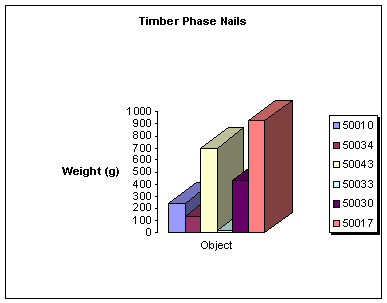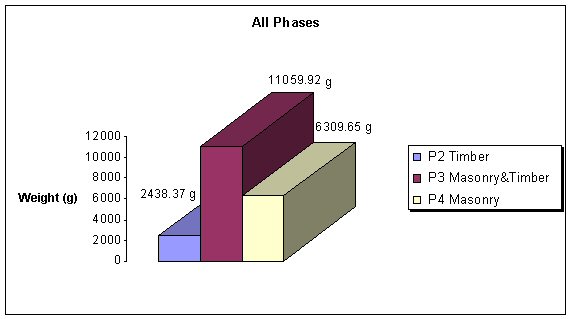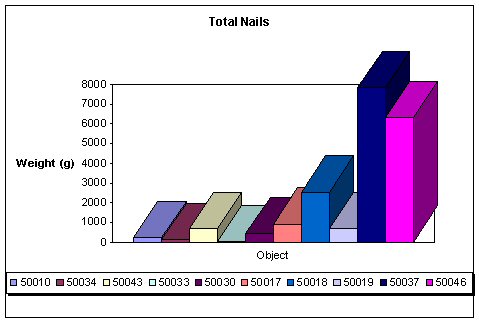
Graph 1:
Nails were systematically collected from all contexts and quantified by weight. A system of sub-sampling addressed the question of nail length and typology. Detailed studies were made of nails found in situ in beam slots of the timber buildings of Period 2. The comparative rarity of bent nails in these contexts suggested that timbers had been left in place to decay. Typologically, the vast majority of nails belonged to Mannings type 1b (Manning 1985). Quantities of nails varied between periods and between buildings within periods, but the largest quantity derived from Period 3, notably from Timber Building 4, which, by itself, represents more than twice the total currently attributable to Period 2.
Nails are the most common iron find on most Roman sites. However, with few exceptions, very little is ever written about them in excavation reports. This section of the report will look at the general quantities of nails found throughout the 'House 1' sequence in relation to the objects in which they are found, and their relationship to the different periods. It will also look in greater depth at the in-situ nails that have been found, mainly from the remains of timber beam-slots.
Unfortunately, due to the corroded and fragmentary condition of the majority of the nails, and in consideration of the large quantities found, it was decided that rather than measure all the nails, a small sample of measurements would be taken from which to estimate the ratios of nails of different lengths. The majority of the quantitative information would be taken from the weights of the nails.
A more detailed study took place of the beamslot nails, which were all measured and any anomalies were noted. If the nails retained their heads, these were measured, and if any were bent or mishapen then this too was recorded. The typology used for the nails is based on Manning (1985). The only problem that arose from the study of the beamslot nails is that their locations only began to be recorded in detail from 2003.
As the Period 2 Timber Building 2 is not completely excavated at the time of writing, this report is only an interim study of the nails associated with it.
There are two rooms in this building; Room 1 which has provisionally been interepreted as a kitchen (Matrix 290, O50043), and Room 2, presumed to be an annexe to Room 1, and possibly used as a living area (Matrix 291, O50030). The beamslot nails discovered in Early Roman Timber Building 1 were fragmentary but quite numerous.
(FSF03691) consists of a single, almost complete nail measuring 42mm in length. This nail is part of (C5395) which forms part of the middle section of the south-east wall. This section of the building also contains (C5339) which in itself contains two groups of beamslot nails. The first of these, (FSF03616), only contains two single nails, quite long (32mm and 45mm) but of average size and both with flat heads. The second group is much larger (FSF03541) and consists of a group of ten nails. The majority of these nails are incomplete but they include several nails which are much larger than normal, with very large heads (c.25mm diameter). There is also a bent nail in this group. These larger nails may have been used for either heavier timbers or, possibly, for masonry. The final groups of nails within this area of the room are (FSF03641 and FSF03662 ) in (C5378). These two groups may perhaps show different phases of building work, or different rooms. SF3641 is a group of two incomplete nails, but, like the nails in SF3541 they are quite large, with thick shafts. SF3662 is a single beamslot nail, 49mm long with only a small, flat head (11mm diameter).
On the SW wall of Building 1 there was only a small group of nails found within the beamslot, (FSF03471, C5295). This group consisted of three nails, all incomplete, but all falling within the Manning Type 1b form. The longest nail (69mm) is also bent.
Within the NW beamslot in Room 1 we find our largest group of beamslot nails so far. This group (FSF03504, C5320) consists of 15 nails in total, all of which are incomplete, and vary between average sized nails and quite thick shafted nails. Only one of the nails was bent. Phase 2 of Room 1 (O50037) has just one group of beamslot nails, with ten nails in total. All the nails are incomplete and measure between 10mm - 45mm in length. Of the heads that are present, these measure 17-18mm in diameter and are flat. There are no bent nails in this group. Room 2 of timber Building 1 (O50030) appears to be an annexe off of room 1, and due to the opus signinum flooring within the room, has been interpreted as a living area.
The only beamslot nails from Room 2 come from the NE wall between rooms 1 and 2 (the annexe). This is a group of 6 beamslot nails (FSF03528, C5332), has only two complete nails within the group. Most of the shafts of these nails are thinner than average, but still fit in neatly with the Manning Type 1b forms. These nails, due to their locality, fall in both Object 50043 and Object 50030.
All the in-situ beamslot nails from Early Timber Building 1 fall easily within the Manning Type 1B typology. Some of the nails were thicker than others, but nothing outstanding appeared from the study of them. The most numerous beamslot activity took place on the SE wall of Room 1, where there appear to be at least 5 periods or areas of activity.
Timber Building 2, Phase 1 (O50033) has not yet been fully excavated, and at this time has no beamslot nails.
Its north-east end (O50017, Matrix 284) is just 1m away from ERTB1. The phase reported here appears to show Building 2 having approximately seven rooms, of which many would probably have wooden partitions defining them. There are two north-west facing beamslot nail groups, (C5445, FSF04094 and C4645, FSF03467). The first of these groups, SF4094, consists of a group of 7 nails. All but one of the nails are almost complete, and are quite uniform in thickness. In length they vary from the only incomplete nail at 22mm to the longest nail at 63mm. All the retained heads are flat and range from 13mm in diameter to 18mm in diameter. The second group of nails, SF3467, consists of 9 nails in total. There are only 3 nails which are almost complete, the remainder being incomplete shafts with no heads present. The heads of these nails are all flat, and range from 13mm - 20mm in diameter.
At the SW end of ERTB2 is a timber beam-slot which contained 6 nails (FSF03654, C5411). One of the beamslot nails is missing, but the remainder are of a standard form. The two virtually complete nails range from 65-69mm in length. The retained heads measure between 13mm-20mm in diameter and are all flat. There is only one nail (SF3654.6) which is slightly thicker than the others. Just to the SW side of this beamslot group, a group of nine nail shanks was discovered (FSF04060, C5770), all with what appears to be the original wood grain retained on them which has been preserved in the corrosion. Some of these nails were angled. It is not clear whether these were a beamslot nail group, or whether they were just randomly found within the area. The group was accessioned as a 'small find' because of the wood which was retained on the shafts. Just SW of these beamslots, and facing SE, were a group of 12 beamslot nails which unfortunately were not retained separately from the normal nails (FSF03379, C5422). These nails were found the first year the beamslot nails began to be recorded, and the nails appear to have been accidentally reintegrated with the other nails.
On the SE facing wall, further up from the previous beamslots, another short section of beamslot nails was present (FSF04093, C4001) consisting of two nails. Both were incomplete shafts with no heads present. SF4093.1 was of average size, but SF4093.2, although of average length (48mm), was very thick (10mm wide).
On the same stretch of wall, a single beamslot nail was found (FSF03397, C4096). It was virtually complete, with a square profile, but the head was quite long rather than being circular (c.20mm). Upside down, the nail forms an L-shape. This nail appears to have been made with a long head intentionally, and is very unusual. Again within the area of the SE facing wall is a group of 8 beamslot nails (FSF03889, C6461). Most of these are incomplete, and only two retain heads, which are flat. One of the nails is actually a hobnail and should not have been small found in this group. The nails measure between 19mm - 45mm. Only one of the nails is bent, and this occurs about halfway down the shaft. Unfortunately at this time the context has not yet been completely excavated.
Leading off from the SE facing wall was a beamslot containing a group of three nails (FSF03382, C4087). Two out of the three nails were complete, and both of these nails were bent. The third nail was an incomplete shaft, but may also have been bent over originally. The length of these nails varies from 39mm - 57mm, and one had a slightly convex head.
Just to the north east of the circular Timber Building 3, (O50010, Matrix 286) there were two groups of timber beam slot nails. The first (FSF03483, C4441) consisted of a group of 5 beam slot nails, all but one incomplete or fragmentary. Two of the nail shafts were quite thick, while the remainder were of average size. These nails came from a beamslot just north of the actual circular structure and appear to form part of a short N-W wall.
The second group of nails were from a much longer, NW-SE running wall (C6132). This group consisted of 11 beam-slot nails. The wall appears to be the end of Timber Building 2, which faced onto the roundhouse. The nails (FSF03848, C6084) are mainly incomplete, but are of average size and again fall into the Manning 1b typology. Within this group there are two nails which are bent and one head which appears to be quite distorted. SF3848.10 is a complete shaft, quite thick, but it has been bent quite oddly - at the top and sideways.
The third phase of Timber Building 2 (O50034) contains only one group of beamslot nails, with only 2 nails in the group (FSF03457, C3257). The first nail (SF3457.1) is complete, with a quite short shaft (42mm total length), and a flat head measuring 16mm diameter. The second nail is incomplete, with no head, however the nail is bent.
No beam slot nails have been recorded from the round house at this time.
Except for a small number of thicker nails, the majority of timber beamslot nails from this phase are typically Manning Type 1b. There is some evidence of re-use or extraction from the bent nails, but this is minimal. A more precise analysis is not possible at this time as the Timber phase has yet to be fully excavated.
Masonry Building 1 was constructed on the site of Timber Building 2 (O50018, Matrix 295). This building has three different groups of beamslot nails from the same context (C5412). (FSF03409) is a single nail, incomplete, and of average size. (FSF03449) has two nails in the group, again of a typical Type 1b format and incomplete. (FSF03418) is by far the largest group in this area of the room, with a total of 16 beamslot nails. They are mainly incomplete, and range in length from 14mm - 70mm. Of the nail heads present, all are flat and range in diameter from 12mm to 22mm. Within the group there are four nails which are slightly bent.
Unfortunately, due to the corroded and fragmentary condition of the nails, plus the vast quantities found, it was decided that rather than measure all the nails, a small sample of measurements would be taken, to estimate whether they fell within the general size ratios, but the majority of the information would be taken from the weights of the nails.
The nails were quantiified into their Object groups, with each context in a specific object being weighed separately, and the total weight of nails from each context added together to give the Object weight (Table 1 and Graph 1).
| Object | Weight (g) |
|---|---|
| 50010 | 241.02 |
| 50034 | 130.78g |
| 50043 | 692.97g |
| 50033 | 15.03g |
| 50030 | 431.21g |
| 50017 | 927.36g |
By studying the weights of the different objects in the Early Roman Timber phase (Period 2), it is evident that Object 50017, associated with Timber Building 2, the largest of the three buildings of this period, has the greatest quantity of nails in it.
Following this, Object 50043, associated with Timber Building 1, has much less, but in comparison with the other Objects, has nevertheless produced a large quantity of nails. If this building was, as interpreted, used as a kitchen area, this may explain the large quantities of nails found. There is the possibility that shelving was attached to the walls to hold cooking utensils and cupboards may possibly have been constructed too. Object 50033 (Period 1) has not yet been fully excavated, but it has yielded just over 15kg of nails to date.

Graph 2:
Period 3 shows considerable variation in the quantities of nails (Table 2 and Graph 2). Object 50019, associated with Masonry Building 2, has the smallest number of nails, with just over 700g. Object 50018, associated with Masonry Building 1, had a much higher number, with over 2500g. Object 50037, associated with Timber Building 4, had, probably by virtue of the nature of its construction, the greatest quantity of nails at almost 8kg.
| Object | Weight (g) |
|---|---|
| 50046 | 6309.65 |
There was quite a large quantity of nails from Object 50046 associated with Masonry Building 3 whose ground plan embraces that of both the masonry buildings of Period 3.

Graph 3:
| Period | Weight (g) |
|---|---|
| P2 Timber | 2438.37 |
| P3 Masonry and Timber | 11059.92 |
| P4 Masonry | 6309.65 |
Table 4 represents the total quantity of general nails per period. It shows that the largest quantity of nails were used during Period 3, the first masonry phase. During this phase over 11kg of nails were either lost during periods of construction, or in-situ within the house, but a significant proportion (70%) derived from the Timber Building 4.

Graph 5: Total Nails from all Objects
The first general study of the nails from all the periods of the House 1 sequence shows that the great majority of the nails were of a standard size and form, that of Manning's Type 1b. Around 95% of the nails measured between 20-70mm, with many fragmentary pieces, and most had flat heads. Due to the lack of in situ recording of nails prior to 2004, and the fact that much of Period 1 has yet to be excavated, we do not have an accurate picture of the beamslot groups from the earliest period.
© Internet Archaeology
URL: http://intarch.ac.uk/journal/issue21/4/finds_nails.htm
Last updated: Wed Sept 12 2007